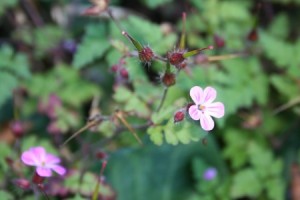
Herb Robert is a common garden invader and problem for its ability to move around with garden soil, plants, pets and clothes. Photo by R. Emanuel.
Most gardeners are unaware that they often inadvertently play roles in the spreading invasion of noxious weeds. But they also can learn to avoid, guard against and eliminate plants that try to escape the boundaries of their gardens.
“Biologists estimate that between 30 and 80 percent of invasive plant species introduced to the United States originated as garden plants,” said Linda McMahan, one of the authors of a new Oregon State University Extension publication, “Invasive Species: What Gardeners Need to Know,” EM 9035, available online at http://bit.ly/pEGJVQ
“In Oregon alone, 21 designated noxious weeds cost approximately $125 million a year in production losses, fire damage and control,” she said. Researchers have determined that almost half of the 1,000 plants and animals protected under the U.S. Endangered Species Act have been listed because of biological invasions.
Plant invasion occurs in three distinct phases:
Introduction. Gardeners can introduce and establish invasive species as they bring a new plant into their garden and perhaps share it with neighbors through plant or seed exchange. The plant population may experience a lag time in its reproductive ability, in which it will stay in a controlled situation such as a garden, forest or pasture. The plant does not appear to be overly aggressive. In some cases, the lag period can persist for decades.
Escape. During the second phase, an escaped plant appears to jump out of the garden into the neighboring landscape. Often this means a plant has overcome barriers that have kept it in check and prevented its spread. These barriers may include temperature, moisture, pests or competition from other plants.
Invasion. Eventually, the plant population shows signs of invasion. During this phase, the plant rapidly reproduces by sexual means (seeds) or asexual means (roots/rhizomes or creeping stems) and may spread over large distances.
The OSU Extension publication points out that gardeners can take control over the introduction and escape phases of a new invasion if they evaluate their potential plant choices first. “Responsible consumers can become informed prior to making a purchase,” McMahan said. Several websites can point the way (see below).
Sometimes a plant’s invasive potential can be arrested by watching it grow in the garden. When a plant starts to show an ability to escape the designated garden or landscape boundaries, the gardener needs to deadhead, trim or otherwise prevent the plant from escaping.
If someone gives you a start or seed, ask where the plant is from and if it is native to Oregon. How successful was the plant in the garden? Does the plant produce many seeds that sprout more than a few feet away from the original plant?
What are the alternatives to invasive species? The publication strongly recommends that they be replaced with Pacific Northwest natives and advises how to get rid of invasive species already in the garden. Many nurseries carry and order more native plants than previously, McMahan said.
Websites to help identify invasive species:
• Oregon Department of Agriculture’s Oregon State Noxious Weed List is an authoritative listing of plants officially designated as noxious weeds in the state. http://egov.oregon.gov/ODA/PLANT/WEEDS/statelist2.shtml
• Oregon Public Broadcasting’s Silent Invasion website provides a photographic list of invasive species of concern in Oregon. http://www.opb.org/programs/invasives/guide.php
• The United States Department of Agriculture Natural Resources Conservation Service’s PLANTS Database allows the user to track plants for their occurrence in individual counties throughout 49 states. Users can use the website to determine whether a plant is invasive by referring to the Invasive and Noxious Weeds page. http://plants.usda.gov/java/noxiousDriver
• Closer to home (for me), Clean Water Services maintains a website with a focus on identifying non-native invaders in our area. http://cleanwaterservices.org/Residents/JoinTheCycle/InYourYard/Invasives/
• Also, check out the 4 County Cooperative Weed Management Area and their compendium of Portland-area weeds: http://4countycwma.org/urban-weed-control/
• The University of Montana’s Invaders Database System allows users to search for invasive species by name, state or area in the five northwestern states or access lists of noxious weeds for all U.S. states and six Canadian provinces. http://invader.dbs.umt.edu

Hey Rob,
Congrats on the career move! Hope things are going well. Glad to see the blog still rolling along. Drop me an email when you get a chance so we can catch up.
Chad
Hi Chad. I’ll send you my professional contact info when I get a chance at work sometime. I’m happy with the move, but sad to leave behind some great colleagues! Brad and I will have some business together now though since we’re practically neighbors and I’m working on riparian forestry issues now for my new employer. If you have anything (pubs, whatnot) that you’d like me to promote via the blog, just drop me a line!
Rob